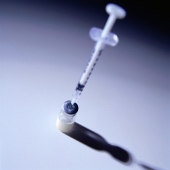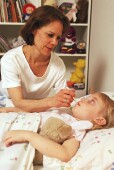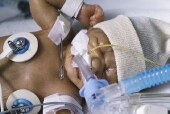| 
Most U.S. Kids Getting Recommended Vaccinations
 THURSDAY, Sept. 4 (HealthDay News) -- The vast majority of American children are getting their recommended vaccinations, federal health officials said Thursday.
According to the U.S. Centers for Disease Control and Prevention, immunization rates remain at or near record levels, with at least 90 percent coverage for all but one of the vaccines in the recommended series for children.
The CDC's 2007 National Immunization Survey also found that 77.4 percent of children have been fully vaccinated with all the recommended vaccines, with no differences for any racial or ethnic groups. And less than 1 percent of children have not received any vaccinations by ages 19 to 35 months.
"Vaccines save lives and prevent suffering," CDC Director Dr. Julie Gerberding said during a Thursday teleconference. "Over time, vaccinations have prevented about 14 million cases of vaccine-preventable diseases and 33,000 premature deaths."
A recent outbreak of measles highlights the continued need for vaccinations, Gerberding said. "Many of the children who were affected by this were not vaccinated adequately against measles, because their parents chose not to do so, and some of them were children who were just too young to be fully immunized."
Diseases such as measles can still be imported for many other places in the world. "We are basically one traveler away from creating a threat to unvaccinated kids. We have to remain vigilant, and we can't let down our guard until the whole world is protected as we are," Gerberding said.
Dr. Anne Schuchat, director of the National Center for Immunization and Respiratory Diseases, noted during the teleconference that vaccinations also save about $44 million over the lifetime of vaccinated children in direct and indirect costs.
The findings in the vaccination study, published in the Sept. 5 issue of the CDC's Morbidity and Mortality Weekly Report, were gathered from a survey of more than 17,000 vaccination records of children born between January 2004 and July 2006. The survey included vaccinations up to the ages of 19 to 35 months, Schuchat said.
According to the CDC, the recommended vaccines include four doses of diphtheria, tetanus and pertussis vaccine (DTaP); three doses of polio vaccine; one or more doses of measles, mumps and rubella vaccine (MMR); three doses of Haemophilus influenzae type b vaccine (Hib); three doses of hepatitis B vaccine; and one or more doses of varicella, or chickenpox, vaccine.
According to the CDC, vaccinations should start shortly after birth and continue to age 2. The last dose of the DTaP vaccine is the only vaccine that hasn't achieved 90 percent coverage. Coverage for this vaccination remains at 84.5 percent, the report said.
For the first time, 2007 saw 90 percent coverage for the varicella vaccine and for the third dose of the pneumococcal conjugate vaccine (PCV). Coverage with four doses of the PCV vaccine has reached 75.3 percent. The PCV vaccine protects against several types of meningitis, pneumonia, bloodstream infections and ear infections, according to the report.
Vaccine coverage did, however, vary between the states from 91.3 percent in Maryland to 63.1 percent in Nevada. Vaccination coverage also varied in the 14 metropolitan areas covered in the CDC survey. In Philadelphia, the city with the highest coverage, 82.2 percent of children had received all the recommended vaccines, compared with 69.6 percent of children in San Bernardino, Calif., the area with the lowest coverage.
"There is still a vaccine coverage gap in poor children compared with others," Schuchat said. "The good news this year is that the gap between those children living in poverty and other children is narrowing. So, we are making progress, but we are not finished with all the work we have to do," she said.
Dr. Pascal James Imperato, dean of the master of public health program at the State University of New York Downstate Medical Center in New York City, called the new report very good news.
"What is significant about this is that this is the age group that historically over the past two decades has been hard to raise immunization levels," Imperato said.
"Viruses brought into the country with individuals coming from a high endemic area will quickly find their way into an unimmune cluster of individuals, as we have seen from time to time with diseases such as mumps and pertussis and measles," he said.
More information
For more on vaccinations, visit the U.S. Centers for Disease Control and Prevention.
|  |

Kids' Fever Time Cut Using Ibuprofen First
 WEDNESDAY, Sept. 3 (HealthDay News) -- Fever in young children can be reduced for a longer period of time by giving them ibuprofen first, followed by paracetamol plus ibuprofen, according to British researchers.
The study included 156 children, ages 6 months to 6 years, who had a temperature of between 37.8 and 41 degrees Celsius (100.04 to 105.8 F) due to an illness that could be managed at home. The children were randomly selected to receive either paracetamol plus ibuprofen, just paracetamol, or just ibuprofen.
The children's parents were instructed to give the medicines for up to 48 hours -- paracetamol every four to six hours (maximum of four doses in 24 hours), and ibuprofen every six to eight hours (maximum of three doses in 24 hours).
The researchers assessed the children's condition after 24 hours, 48 hours and five days. They found that in the first four hours, children given both medicines spent an extra 55 minutes less time with fever compared to those given paracetamol alone. But giving two medicines was not markedly better than just giving ibuprofen.
After 24 hours, children given both medicines experienced 4.4 hours less time with fever than those who received just paracetamol, and 2.5 hours less time with fever than children who received just ibuprofen.
"Doctors, nurses, pharmacists and parents wanting to use medicines to treat young, unwell children with fever should be advised to use ibuprofen first and to consider the relative benefits and risks of using both medicines over a 24-hour period," wrote the researchers, from the University of Bristol and the University of the West of England.
The study was published online Sept. 3 by the British Medical Journal.
This study showed that longer action ibuprofen was the most suitable medicine to use for fever in children, Dr. Anthony Harnden, of the University of Oxford, wrote in an accompanying editorial. The fact that 31 children in this study received an overdose shows that it's easy for parents to overdose their children, which means that a "more complicated alternating regimen of paracetamol and ibuprofen may be less safe than using either drug alone."
More information
The Nemours Foundation has more about children and fever  . .
|  |

College Freshmen See Rx Drug Misuse More Risky Than Alcohol, Pot
 WEDNESDAY, Sept. 3 (HealthDay News) -- Freshman college students think the occasional use of prescription drugs for non-medicinal purposes poses a greater risk to their health than smoking pot or knocking back five drinks every weekend, a new study indicates.
But cocaine is perceived as far more dangerous than any of those habits, the series of surveys revealed. And the researchers noted that students generally prone to engaging in attention-seeking behavior -- along with those who simply don't view unauthorized prescription drug use with much alarm -- are at the greatest risk for abusing prescription painkillers and stimulants.
"The important point here is that risk perception is very important in determining whether or not a person is going to use non-medicinal prescription drugs", said study author Amelia Arria, associate director of research with the Center for Substance Abuse Research at the University of Maryland. "And the ones who use these drugs don't perceive the high risk as often."
"However, the anecdote that's out there that everyone is using these things because they think it's safe is not the case, in general or among college kids," she added. "A lot of these students perceive a risk, and not a lot are using them. It's just that among the very small population who are taking these drugs, there is less of a likelihood that they perceive any risk."
The study was sponsored by the National Institute on Drug Abuse and is described by the research team as the first to explore college student views of the dangers of non-medicinal prescription drug use. The findings were published in the September issue of Prevention Science.
The authors noted that as recently as in 2005, among people of all ages, the non-medicinal use of painkillers and stimulants was associated with more than 175,000 visits to the emergency room.
And in 2007, a Partnership for a Drug-Free America survey of teenagers and their parents indicated that more than half of those teens that had tried such drugs viewed them as safer than so-called "street drugs."
To specifically gauge college student perceptions regarding non-medicinal use of prescription drugs, Arria and her colleagues analyzed data collected by the ongoing "College Life Study".
Between 2004 and 2006, just over 1,250 first-year undergraduate college students were interviewed to assess their inclinations toward attention-seeking behavior; their drug use history; and the relative degree to which they perceived prescription drugs (both analgesics and stimulants), alcohol, marijuana and cocaine to be harmful.
Six months later, the participants -- all of whom attended a "large public university in the mid-Atlantic region" that the authors described as ethnically diverse -- completed a Web-based follow-up survey. Six months after that, a second in-person interview was conducted.
While approximately a quarter of all the students expressed the view that occasional non-medicinal prescription drug use involves little or no risk, just over a quarter said they thought that such use of stimulants and analgesics entails a "great risk."
This risk perception fell far short of the danger the students attributed to the occasional use of cocaine, which more than 72 percent said involved similar "great risk."
However, unauthorized prescription drug use was thought to be more risky than smoking marijuana or drinking five or more alcoholic beverages each weekend -- each of which was described as similarly risky by approximately 7 percent and 17 percent, respectively.
When honing in on those students who said they had had an opportunity to use unauthorized prescription drugs, two out of three said they viewed such behavior as risky to some degree.
In sum, the authors concluded that -- contrary to common anecdotal evidence -- most students share the view that non-prescribed stimulant and analgesic use is moderately or highly risky.
Although ethnicity was generally unrelated to risk perceptions, the researchers noted that prior non-medical use of prescription drugs was linked to a relatively low concern that such behavior might prove harmful.
Those students who expressed such low concern were found to be about 10 times as likely to have used stimulants not prescribed for them in the prior year, when compared with those who perceived non-medicinal drug use as highly harmful.
Those who perceived non-medical prescription drug use as safe were found to be more likely to engage in such use regardless of how driven (or not driven) they were toward seeking out attention, sensation and excitement.
However, those who viewed such use as highly harmful but were at the same time characterized as "high sensation-seekers" were not as dissuaded from such drug use as were similar-thinking students who expressed less interest in novel or dangerous experiences.
"But what we're talking about here is not rocket science," said Arria. "Using a prescription drug without a prescription is risky behavior. And for most students, the more we can do to accurately convey this fact, the better we'll be at dealing with the problem."
"This kind of prescription drug use represents a serious hazard that is greatly underestimated by college-age youth and young adults, and potentially can represent a major public health problem even greater than it is now," said Dr. Marc Galanter, director of the division of alcoholism and drug abuse in the department of psychiatry at New York University School of Medicine. "So, it's very important that college-aged students -- and for that matter older adults -- be as well-informed and educated of this serious risk as possible."
More information
For more on youth and non-medicinal prescription drug use, visit The Partnership for a Drug-Free America  . .
|  |

Extremely Preemie Babies Prone to Behavior Woes Later On
 TUESDAY, Sept. 2 (HealthDay News) -- A study looking at children born extremely prematurely (at or before 25 weeks of gestation) finds they are at significantly higher risk for behavior problems by age 6, with boys particularly vulnerable.
"Attention problems and social problems with peers have been reported previously" in children born prematurely, noted study lead author Dieter Wolke, professor of developmental psychology and individual differences at the University of Warwick in the United Kingdom.
But the study, which compared parent and teacher reports of behavior problems at age 6 in 200 children born preterm against 148 children who were born full-term, is more comprehensive, he said, and draws from more than one center. "Most previous studies have used parent reports, very few teacher reports," Wolke said, while his study used both. "Parent reports can be biased," he noted.
The new findings were published in the September issue of the journal Pediatrics.
In the study, teachers and parents were asked about emotional problems, conduct, hyperactivity, peer problems, social behavior and adaptability to school.
Overall, 19.4 percent of the extremely preterm children had behavior problems, but just 3.4 percent of the control children did. "We found that already in 6-year-olds, the extremely preterm child had four times more often emotional problems (anxiety, depression) than controls," Wolke said. "This has not been reported for larger preterm [born after 25 weeks but not full term] children."
Boys were twice as likely as girls to suffer behavioral problems, the researchers found. When they assessed children's cognitive functioning, it explained the hyperactivity and conduct problems, but problems such as poor attention, poor peer relations and emotional problems couldn't be explained by cognitive function, Wolke said.
So what's at the root of the difficulties? It's not known for sure, Wolke said. But he suspects they are due to "altered brain development from white to grey matter that takes place between 24 to 27 weeks' gestation."
The study is a landmark one, noted Dr. K.J.S. Anand, an attending physician at Arkansas Children's Hospital and a professor at the University of Arkansas for Medical Sciences, Little Rock. He has also done much research on the topic.
With his colleagues, Anand has proposed a possible mechanism, saying the problems may be the result of the maternal separation experienced by these extremely premature infants, impacting the developing brain.
Because some children were lost to follow-up, Anand said, "it is likely that their results may even underestimate the true prevalence of these problems in society."
While Wolke said the problems are child-driven, a result of brain development, and that parents as such can't do much, Anand suggested that greater contact between parents and babies during the first days after delivery may help.
More information
To learn more about preterm birth, visit the March of Dimes  . .
|  |
|